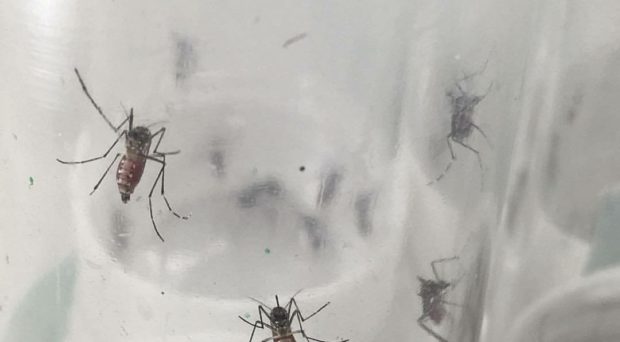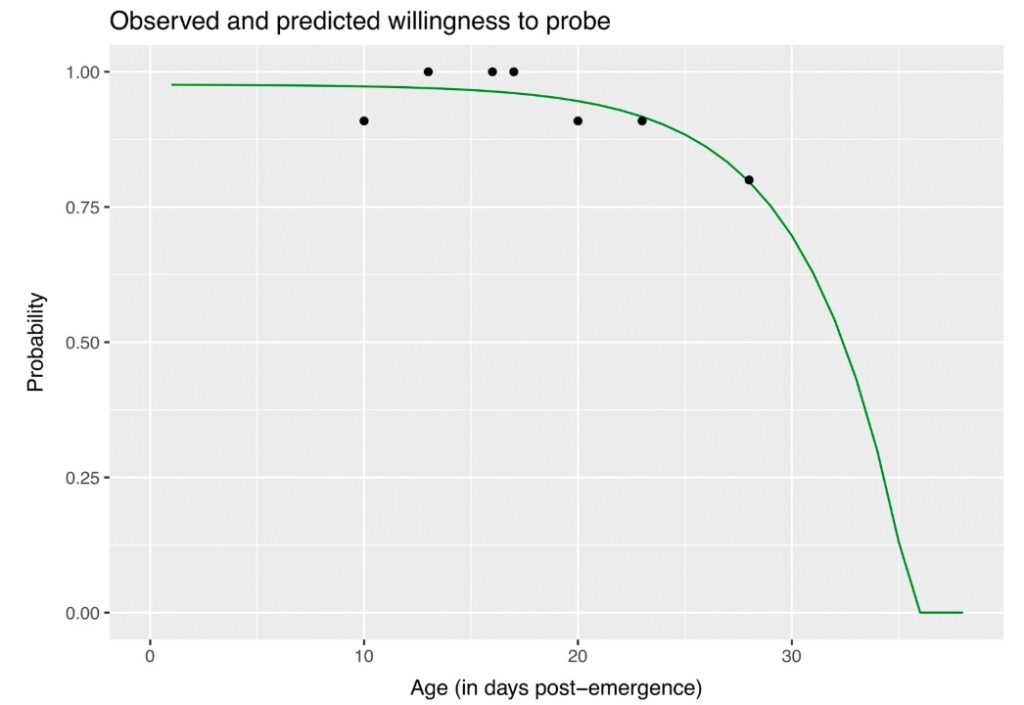
Time waits for no virus.
A female mosquito takes a bloodmeal with virus in it. If the virus infects the midgut, travels through the mosquito body, and is then able to infect the salivary glands, the mosquito can inject that virus to a susceptible host the next time it bites, becoming a virus vector. Sounds simple enough (narrator: it is not!).
A common way vector-virus pairings (herein: “pairing”) are judged as efficient (read: good at keeping transmission going) or not is through a combination of vector competence, the extrinsic incubation period (EIP), and summary metrics like vectorial capacity (VC). We initially set out to determine how age might affect vector competence and EIP, and how we could better plug them in to the VC equation because everybody loves math.
Vector competence (the % of exposed mosquitoes that will transmit): Vector competence is a spectrum. Let’s say a pairing has “high” vector competence: 50% of exposed mosquitoes will go on to transmit the virus. On the other hypothetical hand, let’s say a pairing has “low” vector competence: only 10% will transmit. We have, as a field, attributed levels of fitness to higher percentages of vector competence. Bigger is better, right?
EIP (the time it takes for all this intra-mosquito virus travel to occur): EIP is not a single number and is instead a distribution that is dependent on many factors – both intrinsic to the virus and/or the vector, as well as external factors like temperature (not addressed here).
We prefer to consider the interaction of EIP and vector competence rather than separately, because it accounts for the dynamics of the infection within the mosquito. For example, the EIP50 is the time it takes for 50% of mosquitoes to become infectious. Likewise, you can define EIP10 or EIP42 if you so desire for the time it takes for 10% and 42% of mosquitoes to transmit, respectively.
Vectorial capacity: Everyone loves math, right? VC is a way of taking vector competence, EIP, and a myriad of other mosquito traits and putting it into a mathematical framework that spits out a number. This value can be used to compare pairings or just determine how well a particular pairing might do under a set of circumstances (like environmental variables). The components of vectorial capacity are:
- Biting rate (how often mosquitoes bite on the human population, and usually represented by the letter a) – appears as a2 because it represents the bite where the mosquito gets infected and the one where she transmits.
- Density – how many mosquitoes are there for every human in the population
- Mosquito mortality – dead mosquitoes don’t transmit
- Vector competence and EIP
As I’ve gotten older, I’ve recited the “age is just a number” mantra to justify my love of really corny animal puns and childish pranks. But the saying is not wrong – age is a number, and as such, should be considered when it affects other numbers. For example, mosquito age and mortality are linked because… well, that’s how time works.
In VC, the mosquito mortality is calculated as a probability of living through the EIP without consideration for the age at which a mosquito first gets infected. This is potentially problematic because it does not consider the sliding scale of the other parameters with respect to age/mortality.
We found some interesting things: in our pairing, the EIP and the proportion who were able to transmit were pretty much the same in young versus old mosquitoes. Cool: negative results are results, too!
But even with all these things present and accounted for, transmission cannot occur without biting. So that thinking turned in to additional experiments where we tested the effect of age on biting behaviors of Ae. aegypti. We decouple that a2 term and separated the bite rate into its two components: the bite where she acquires the virus and the bite where she transmits the virus.
What we actually measured was an overall willingness to bite rather than strictly the rate of biting. Turns out, mosquitoes that were young and spry were more likely to probe and/or feed than their older counterparts.

With all of these experimental results, we re-tooled the VC equation to account for mosquito age by looking at traits at the time of the first bite (virus in) and the difference in traits at the second bite (virus out). We then calculated VC for mosquitoes that take infected bloodmeals at age 2 days versus older ladies who don’t get infected until 14 days old.
What we found was that there was a certain window of opportunity for the mosquito to successfully transmit. Outside of that window, a mosquito that got infected would not likely contribute to the transmission cycle because she may die before the EIP or she might not bite again.
Time turned out to be very important. Aside from defining this window of opportunity, it similarly defined a window for the virus. Viruses that get out of the mosquito faster but with lower vector competence have an advantage (up to a point) over viruses that are slower, but maybe have moderately higher vector competence.
Obviously, if a virus is fast and has high vector competence, it wins. But short of that, this throws our idea of transmission fitness into a bit of a tizzy. Vector competence values of <20% are usually considered pretty poor, but given a short enough EIP10, in the context of age, we show they out-do vector competence of 45% and longer EIP. Time waits for no virus.
While it is currently difficult to measure the population age-structure of mosquitoes (sadly, you cannot dissect them and count the rings), researchers are developing technologies to do just this. And when they are successful (glass half full!), this understanding of how time governs the way we think of virus-vector interactions re: transmission will mean some pretty cool studies are yet to come.

Comments